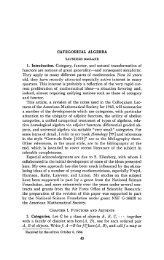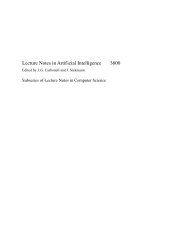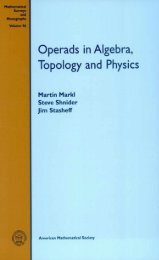Symmetric Monoidal Categories for Operads - Index of
Symmetric Monoidal Categories for Operads - Index of
Symmetric Monoidal Categories for Operads - Index of
You also want an ePaper? Increase the reach of your titles
YUMPU automatically turns print PDFs into web optimized ePapers that Google loves.
2.1 The <strong>Symmetric</strong> <strong>Monoidal</strong> Category <strong>of</strong> Σ∗-Objects and Functors 41<br />
The tensor power M ⊗r is equipped with a Σr-action, deduced from the<br />
symmetric structure <strong>of</strong> the tensor product <strong>of</strong> Σ∗-objects. Let w ∈ Σr be<br />
any permutation. For any partition n = n1 + ···+ nr, we <strong>for</strong>m the block<br />
permutation w(n1,...,nr) ∈ Σn such that:<br />
w(n1,...,nr)(n w(1) + ···+ n w(i−1) + k) =n1 + ···+ n w(i)−1 + k,<br />
<strong>for</strong> k =1,...,n w(i), i =1,...,r.<br />
The tensor permutation w ∗ : M ⊗r → M ⊗r is induced componentwise by<br />
morphisms <strong>of</strong> the <strong>for</strong>m<br />
Σn ⊗ M(n1) ⊗···⊗M(nr) w(n1,...,nr)⊗w∗<br />
−−−−−−−−−−→ Σn ⊗ M(nw(1)) ⊗···⊗M(n w(r))<br />
where we use the tensor permutation w ∗ : M(n1)⊗···⊗M(nr) → M(n w(1))⊗<br />
··· ⊗ M(n w(r)) within the category C and a left translation by the block<br />
permutation w(n1,...,nr) on the symmetric group Σn. This <strong>for</strong>mula extends<br />
obviously the definition <strong>of</strong> §2.1.7 in the case r = 2. To prove the general<br />
<strong>for</strong>mula, check the definition <strong>of</strong> associativity isomorphisms <strong>for</strong> the tensor<br />
product <strong>of</strong> Σ∗-objects and observe that composites <strong>of</strong> block permutations are<br />
still block permutations to determine composites <strong>of</strong> symmetry isomorphisms.<br />
2.1.9 The Pointwise Representation <strong>of</strong> Tensors in Σ∗-Objects. In the<br />
point-set context, we use the notation w · x ⊗ y ∈ M ⊗ N to represent the<br />
element defined by w ⊗ x ⊗ y ∈ Σn ⊗ M(p) ⊗ N(q) in the tensor product<br />
<strong>of</strong> Σ∗-objects<br />
M ⊗ N(n) = �<br />
Σn ⊗Σp×Σq M(p) ⊗ N(q),<br />
p+q=n<br />
and the notation x ⊗ y ∈ M ⊗ N in the case where w =idistheidentity<br />
permutation.<br />
By definition, the action <strong>of</strong> a permutation w on M⊗N maps the tensor x⊗y<br />
to w·x⊗y. Accordingly, the tensor product M ⊗N is spanned, as a Σ∗-object,<br />
by the tensors x ⊗ y ∈ M(p) ⊗ N(q), where (x, y) ∈ M(p) × N(q).<br />
In our sense (see §§0.4-0.5), the tensor product <strong>of</strong> Σ∗-objects inherits a<br />
pointwise representation from the base category. To justify our pointwise<br />
representation, we also use the next assertion which identifies morphisms<br />
f : M ⊗ N → T with actual multilinear maps on the set <strong>of</strong> generating<br />
tensors.<br />
The abstract definition <strong>of</strong> §2.1.7 implies that the symmetry isomorphism<br />
τ(M,N) :M ⊗ N � −→ N ⊗ M maps the tensor x ⊗ y ∈ M ⊗ N to a tensor <strong>of</strong><br />
the <strong>for</strong>m τ(p, q) · y ⊗ x ∈ N ⊗ M, whereτ(p, q) is a block permutation. Thus<br />
the permutation rule <strong>of</strong> tensors in Σ∗-objects is determined by the mapping<br />
x ⊗ y ↦→ τ(p, q) · y ⊗ x.






